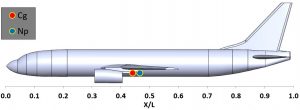In the Spring 2022 semester, the project team set up these goals:
- To conduct two test flights- one to gather energy consumption data, and the other to gather pressure data
- To create a CAD model of the AL37 for Star-CCM+ analysis
- To conduct Star-CCM+ analysis on different airfoils
The team successfully conducted two test flights, both of which were met with success. The results of the first flight have been compiled into a report, while the second flight results are being worked on currently.
AL_37_Flight_Report_1We were able to successfully install the Pixhawk 4 into the AL37 aircraft, which allowed us to determine the discharge rate of the batteries and performance values, such as the airspeed of the aircraft that can then be used for further aerodynamic analysis. The batteries were tested to last 4 minutes, 30 seconds to 5 minutes according to the QGroundControl software, matching our estimations from Fall 2021. The airspeed was recorded with an average of 59 mph at half throttle, with a maximum value of 70 mph.
The AL37 CAD model was successfully created in Solidworks. We were able to then test its airfoil, as well as the NACA-2412 airfoil, in Star-CCM+. This CAD model and the Star-CCM+ resources provided by Professor Travis Grager will allow the team to conduct rapid CFD analysis next semester to determine the optimal wing dimensions and airfoil before we restart the manufacturing process.
The project’s deliverables were to provide two flight reports, the CAD model of the AL37, well as Star-CCM+ results. The team has successfully met all of these deliverables. The CAD model and Star-CCM+ results of the AL37’s airfoil are shown in the figures below.


The team was able to learn significantly about the Pixhawk 4 and the electronics of the aircraft in general. We also continued our practice from last semester of doing better documentation, developing reports about the flights, instructions and schematics of the electronics and servo connections, and how to utilize the QGroundControl software. The team also learned more about the development process of the project while utilizing Star-CCM+ to test new airfoils. Lastly, the team became more familiar with the AL37 and will be able to expand on the current systems with the aircraft in future semesters, such as moving toward semi-autonomous testing. The team will also be able to conduct a more precise CFD analysis of the truss-braced wings to determine an optimal design prior to manufacturing.
BEF Gantt_Week15